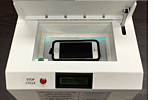Innovation
Canadian company wins big for smartphone sanitizer
November 4, 2015
 BUFFALO, N.Y. – A Canadian firm has won $500,000 (U.S.) for a device that quickly disinfects smartphones, ridding them of superbugs through the use of UV light. The device, called CleanSlate, zaps the phone with UV energy for just 30 seconds, but effectively prevents it from becoming a source of infection for patients in hospitals.
BUFFALO, N.Y. – A Canadian firm has won $500,000 (U.S.) for a device that quickly disinfects smartphones, ridding them of superbugs through the use of UV light. The device, called CleanSlate, zaps the phone with UV energy for just 30 seconds, but effectively prevents it from becoming a source of infection for patients in hospitals.
CBC News reported the company beat out nearly 11,000 applications to win one of six $500,000 US second-place prizes at 43North, the world’s biggest business pitch competition, in Buffalo, N.Y., at the end of October. The winner of the $1 million US grand prize went to Buffalo-based ACV Auctions, an online marketplace for dealer-only car auctions.
CleanSlate CEO Taylor Mann said his company’s smartphone sanitizer was inspired by a conversation with a friend who worked as a nurse in the neonatal intensive care unit at Kingston General Hospital in Kingston, Ont.
She told him that because mobile devices can spread superbugs, they were banned in her unit. But many parents flouted the ban in order to take pictures of their critically ill babies. That put nurses in a tough position – should they crack down on parents at a difficult time in their lives or let the transgression go and potentially put the child and other patients at risk?
Mann learned that similar, and often ineffective, device bans are in place in other intensive care units, emergency rooms, and operating rooms.
The Queen’s University graduate decided to put together a team of Queen’s students to develop a solution at the university’s Innovation Connector, which helps students bring new inventions to market.
“What our engineering team has been able to do is create something that is really safe, really intuitive and very quick,” Mann said. “We’re targeting C. difficile, MRSA, VRE – the really dangerous hospital-borne superbugs that these facilities are really concerned about.”
CleanSlate has already tested its $4,500, microwave oven-sized device at three Ontario hospitals. Mann said it could be positioned at hospital entrances, the entrances to units such as intensive care, and at nursing stations, so staff can disinfect their devices between patients and before they leave at the end of the day so they don’t bring hospital germs home to their families.
Currently, Mann said, that kind of disinfection is done using wipes containing bleach or hydrogen peroxide, which can destroy the touch-sensitivity of a smartphone’s screen over time. The procedure is also time consuming, requiring the device to sit untouched for one to three minutes after being wiped down.
That’s not to say your phone will be completely unscathed by the ultraviolet light produced by CleanSlate – that can cause the white plastic case or casing of some devices to yellow more quickly.
“But if you compare that with actual physical damage that hydrogen peroxide or bleach does, our damage is rather cosmetic,” Mann said.
The company has already started getting pre-orders from Ontario and New York-based hospitals and clinics for its next version of the device, which it hopes to start shipping early next year.
